Kashiwa Mochi is a tender Japanese rice cake filled with sweet red bean paste and wrapped with an oak leaf. We traditionally enjoy this soft and chewy confection on Children’s Day in Japan to celebrate a child’s growth and happiness.
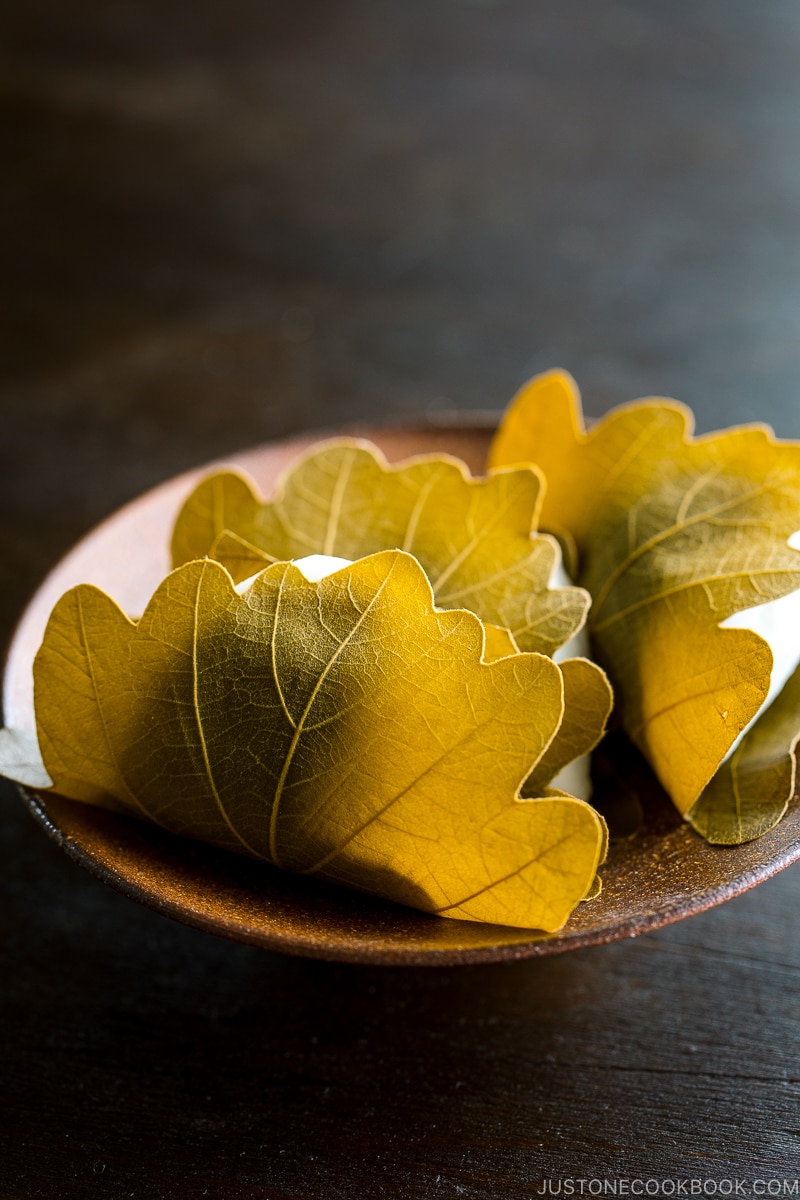
Children’s Day is a special celebration in Japan and it falls on May 5 annually toward the end of Golden Week. On this national holiday, families honor their children by praying for their good health, happiness and growth. As a part of the celebration, we eat Kashiwa Mochi (柏餅), a Japanese rice cake with red bean paste filling wrapped with an oak leaf.
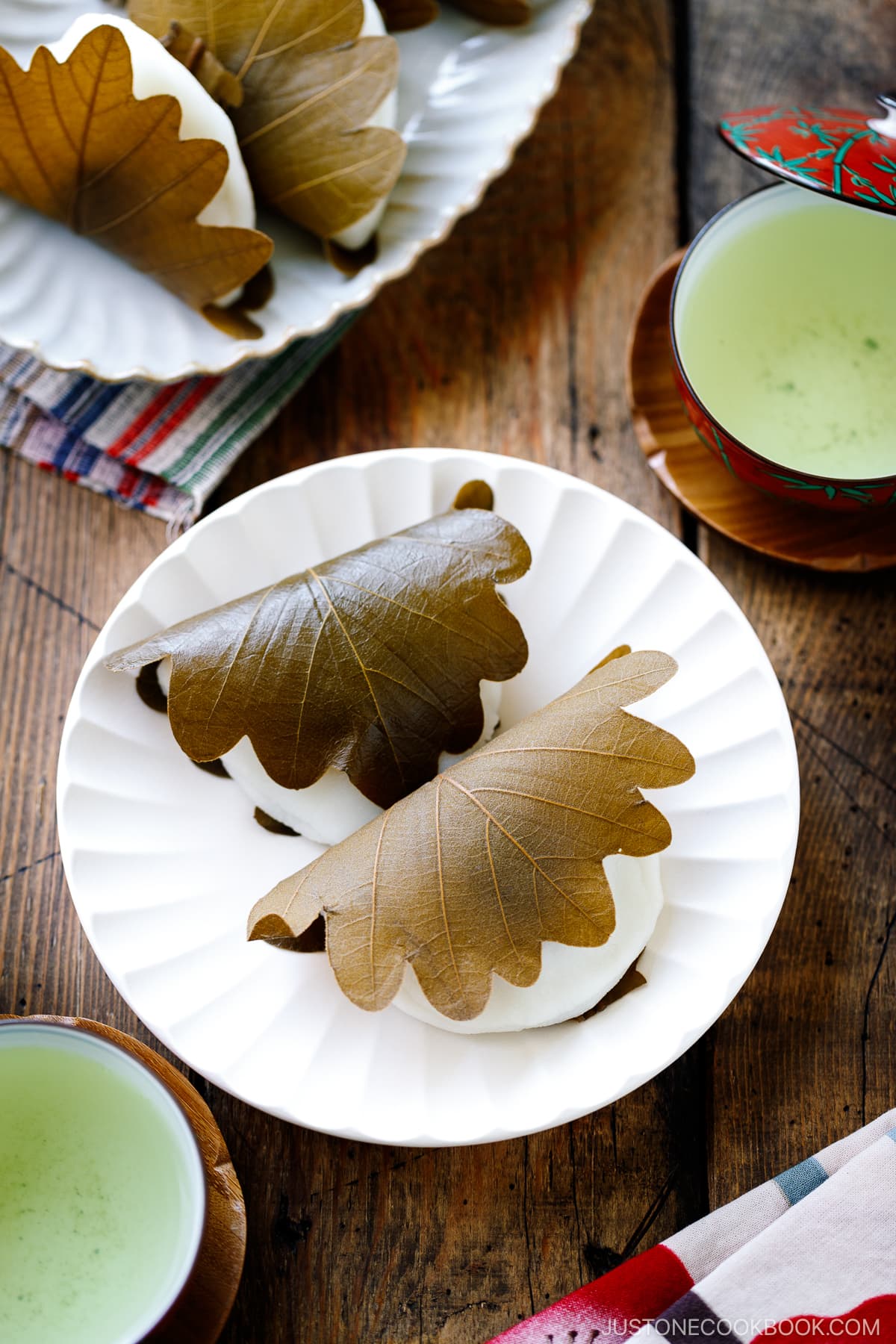
What is Kashiwa Mochi?
Kashiwa mochi is a tender but chewy rice cake stuffed with sweet red bean paste and wrapped in a kashiwa (oak) leaf.
You may wonder why mochi is wrapped in an oak leaf. Since oak trees don’t shed old leaves until new leaves grow, the Japanese consider oak trees as a symbol of the prosperity of one’s descendants.
These oak leaves are not edible; however, they impart a lovely earthy fragrance to the mochi which is really enjoyable. Plus, they elevate the presentation, yielding a stunningly beautiful sweet for the occasion.
History of Kashiwa Mochi
The origin of kashiwa mochi goes back to the mid 18th century during the Edo period and it was mostly enjoyed in eastern Japan.
In the Kansai region and the west of Japan, where the oak trees typically do not grow naturally, chimaki (ちまき, 粽) was served instead of kashiwa mochi.
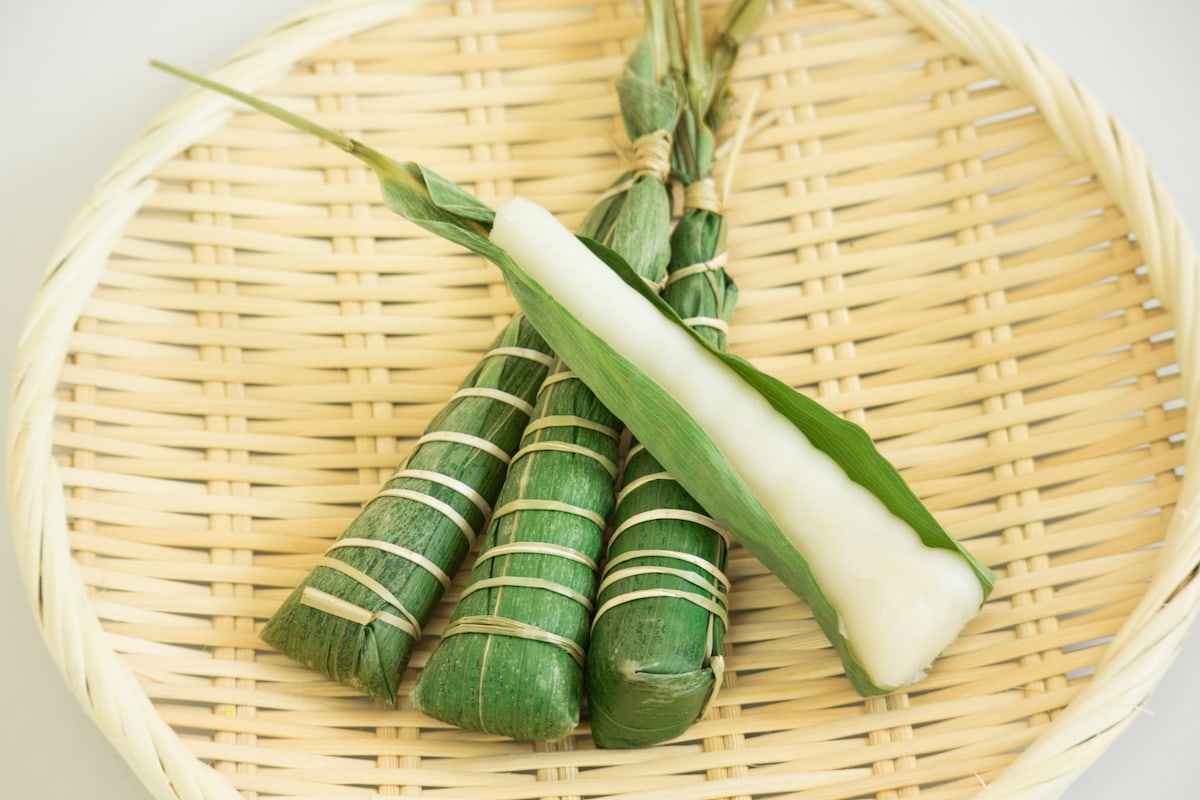
Chimaki is sweet rice dumplings wrapped in bamboo leaves. Unlike kashiwa mochi, these dumplings do not have any filings.
When the imperial capital was in Nara and Kyoto between the 700s and late 1100s (Nara & Heian period), many Chinese cultures and customs were adopted in western Japan. It is believed that chimaki originated from Chinese Zongzi (sticky rice dumplings), which is enjoyed on the fifth day of the fifth lunar calendar for DuanWu Festival (Dragon Boat Festival), typically late May or June.
To this day, the western part of Japan enjoys the Japanese version of chimaki on May 5, Children’s Day while the eastern part of Japan enjoys kashiwa mochi (source).
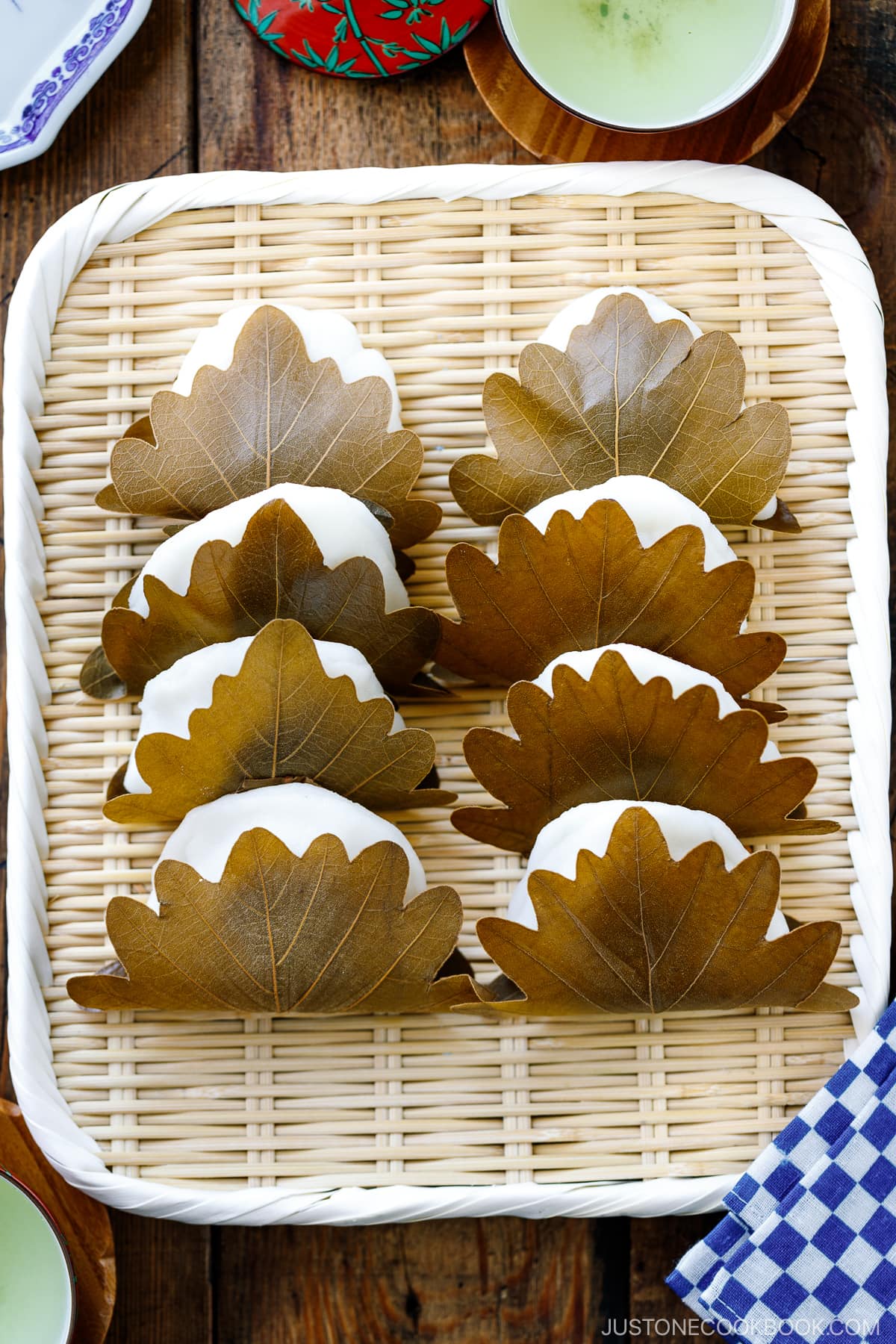
Two Types of Kashiwa Mochi Filling
There are two kinds of fillings for kashiwa mochi: sweet red bean paste and miso bean paste.
- Azuki An (Adzuki bean paste) – Kashiwa mochi stuffed with sweet azuki red bean paste is more popular and widely available.
- Miso An – Miso is mixed into shiroan or sweet white bean paste. I actually never tried the white bean miso version before.
Both red bean and miso-flavored kashiwa mochi look the same at the confectionery shops. How can you tell the filling inside? Take a close look at the oak leaf. These two flavors are differentiated by the black or front side of the oak leaf. For red bean filling, the back of the leaf (veins are more visible) faces outside, and the front of the leaf (smooth side) faces outside for the miso filling.
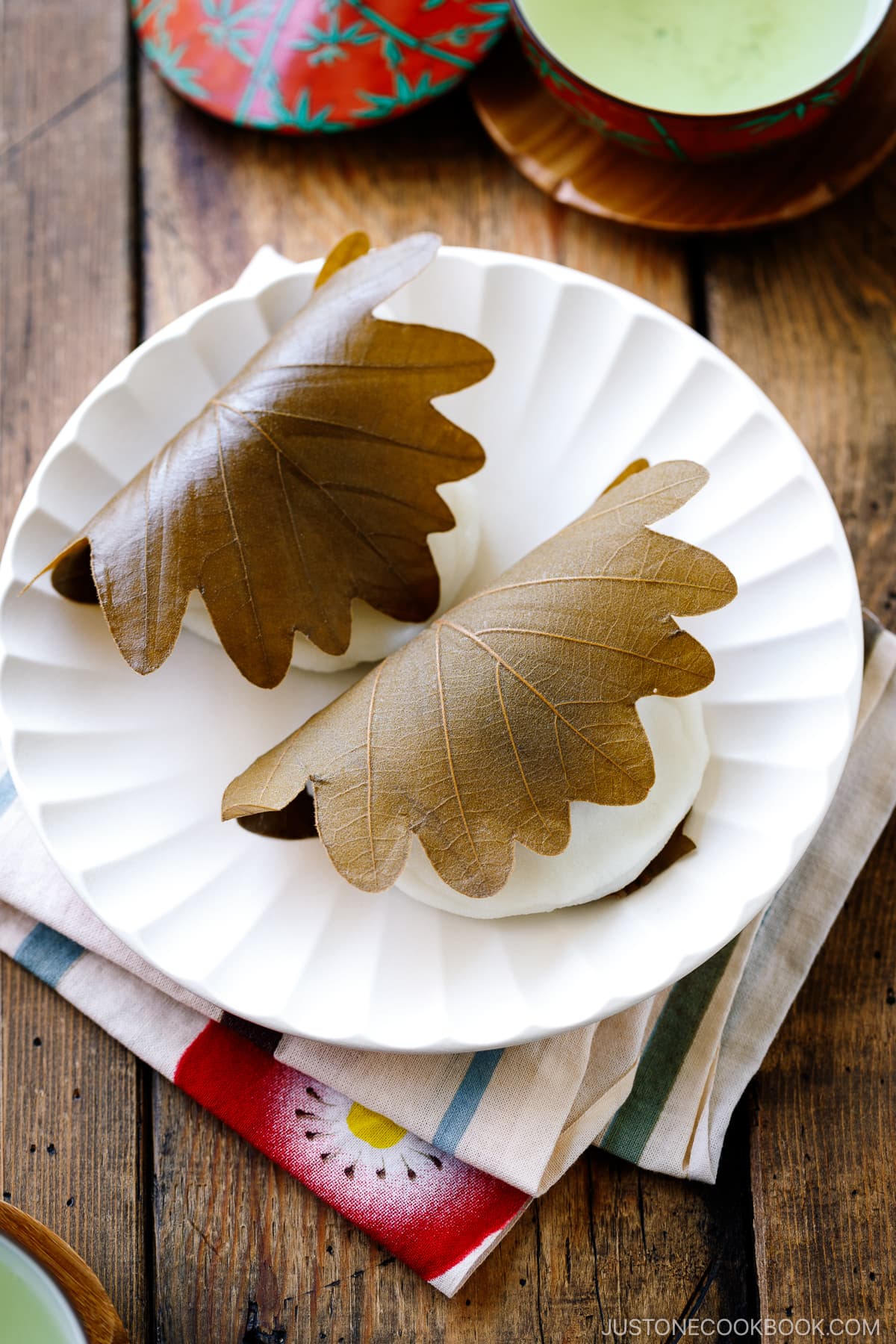
How To Make Kashiwa Mochi
Ingredients You’ll Need
- Kashiwa leaves (oak leaves) – Read more below.
- Sweet red bean paste (anko) – We use koshiana fine red bean paste. Read more below.
- Joshinko (Japanese rice flour) – Read more below.
- Sugar
- Water
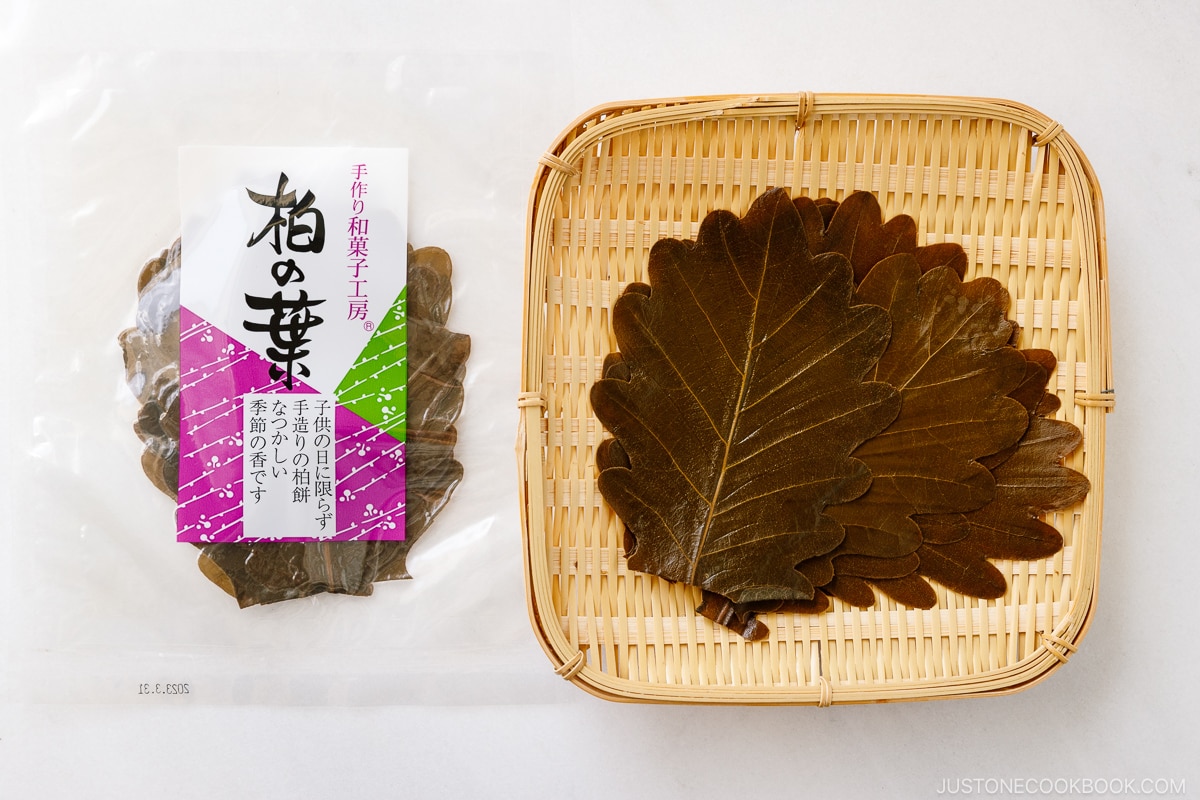
These are kashiwa oak leaves. They are typically vacuum-packed. I got mine from this online shop that ships internationally from Japan. You can also check your local well-stocked Japanese grocery stores.
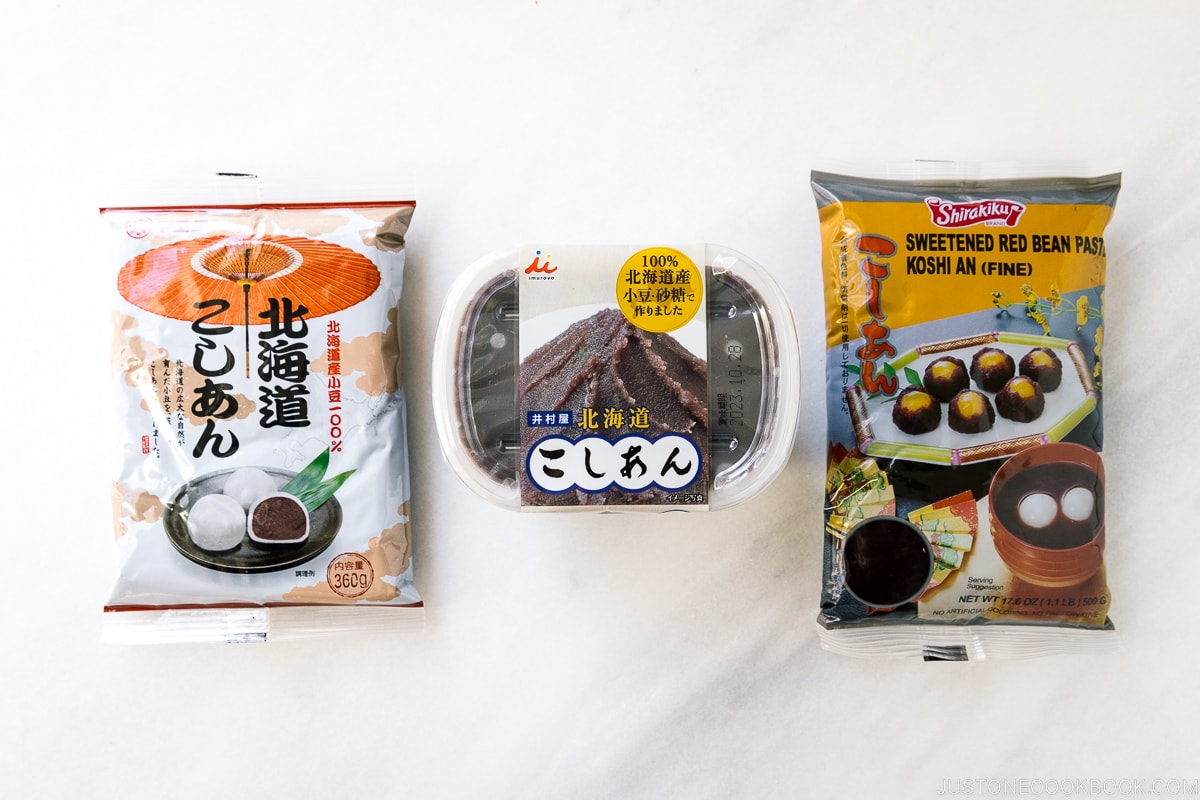
Shown above are different brands of koshian or sweet red bean paste (fine). For this particular recipe, avoid the middle product from Imuraya. It is very delicious and has the best taste compared to the other brands; however, the paste is so fine and soft that it gets difficult to roll into a ball.
You can find a packaged koshian at Japanese or Asian grocery stores. You can also make my Pressure Cooker Anko recipe or Stove Top Anko recipe.
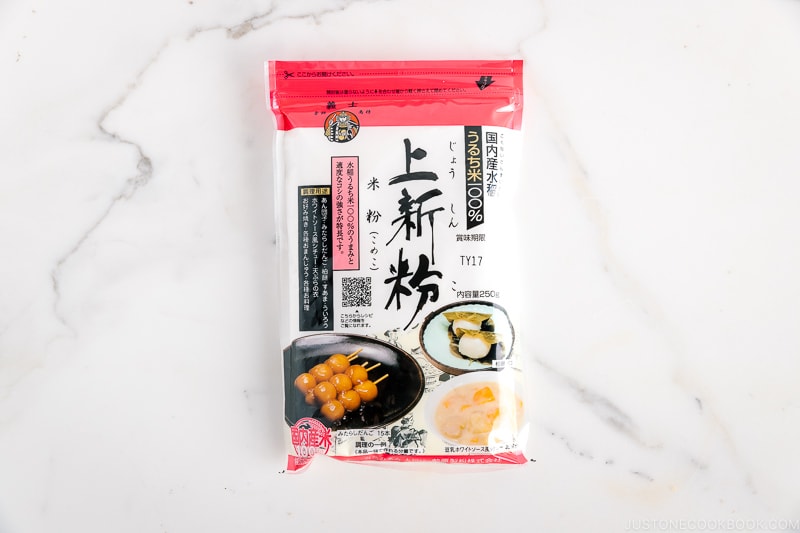
Joshinko (上新粉) is Japanese short-grain rice flour and is different from mochiko or glutinous rice flour or other Asian long-grain rice flour. This rice flour is made from 100% short-grain rice, the same rice we eat regularly.
Kashiwa mochi has a stronger chew and not the typical stretchy mochi texture. Therefore, you can’t use glutinous rice flour like mochiko because the texture of the mochi is completely different.
You can buy it from Amazon or Japanese grocery stores.
Overview: Cooking Steps
- Prepare the filling: Form small balls with the sweet red bean paste.
- Make the mochi mixture: Combine the rice flour, sugar, and water. Microwave the mixture until it becomes translucent and cooked through.
- Pound and knead the mochi: Knead with hands to create a pliable, smooth mochi.
- Shape the mochi: Divide into small cylinders and shape into an oval shape.
- Stuff the filling: Wrap the sweet red bean filling with the mochi and then wrap the mochi with an oak leaf.
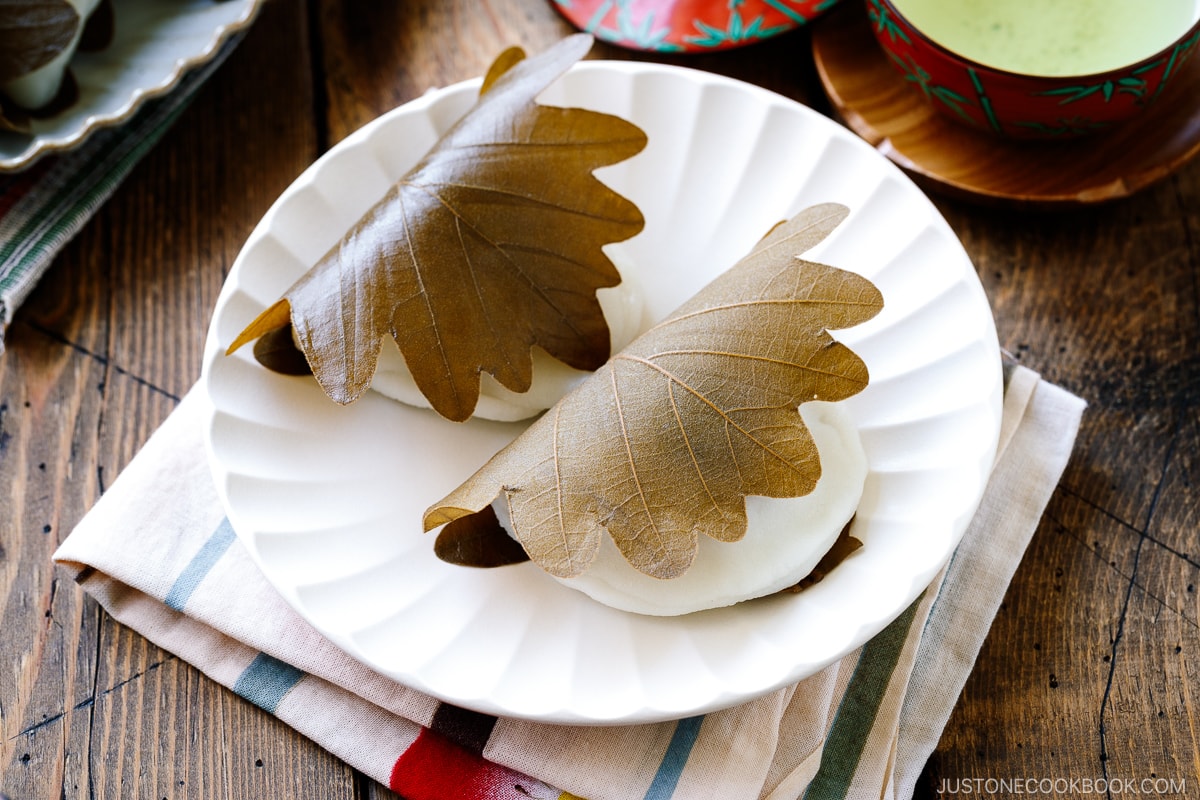
Tips for Making Kashiwa Mochi
- Don’t add all the water to the rice flour mixture. Add about 85–90% of the measured water to the bowl now, and reserve the remaining 10–15% of it for later. When you lift the whisk, the mixture should fall in a thick ribbon pattern that sits on top of the swirl (see my image). You may not need to use all the water or you may need additional water.
- Knead until the mochi becomes more pliable, smoother, and shinier. The right amount of kneading makes the mochi more tender and creates a nice chewy bite. Do not overknead the mochi or it will get tough.
- Dip your fingers in the syrup to avoid the fingers from getting sticky. Place the red bean paste ball in the center of the mochi and fold the mochi in half to seal the mochi’s edges around the red bean paste.
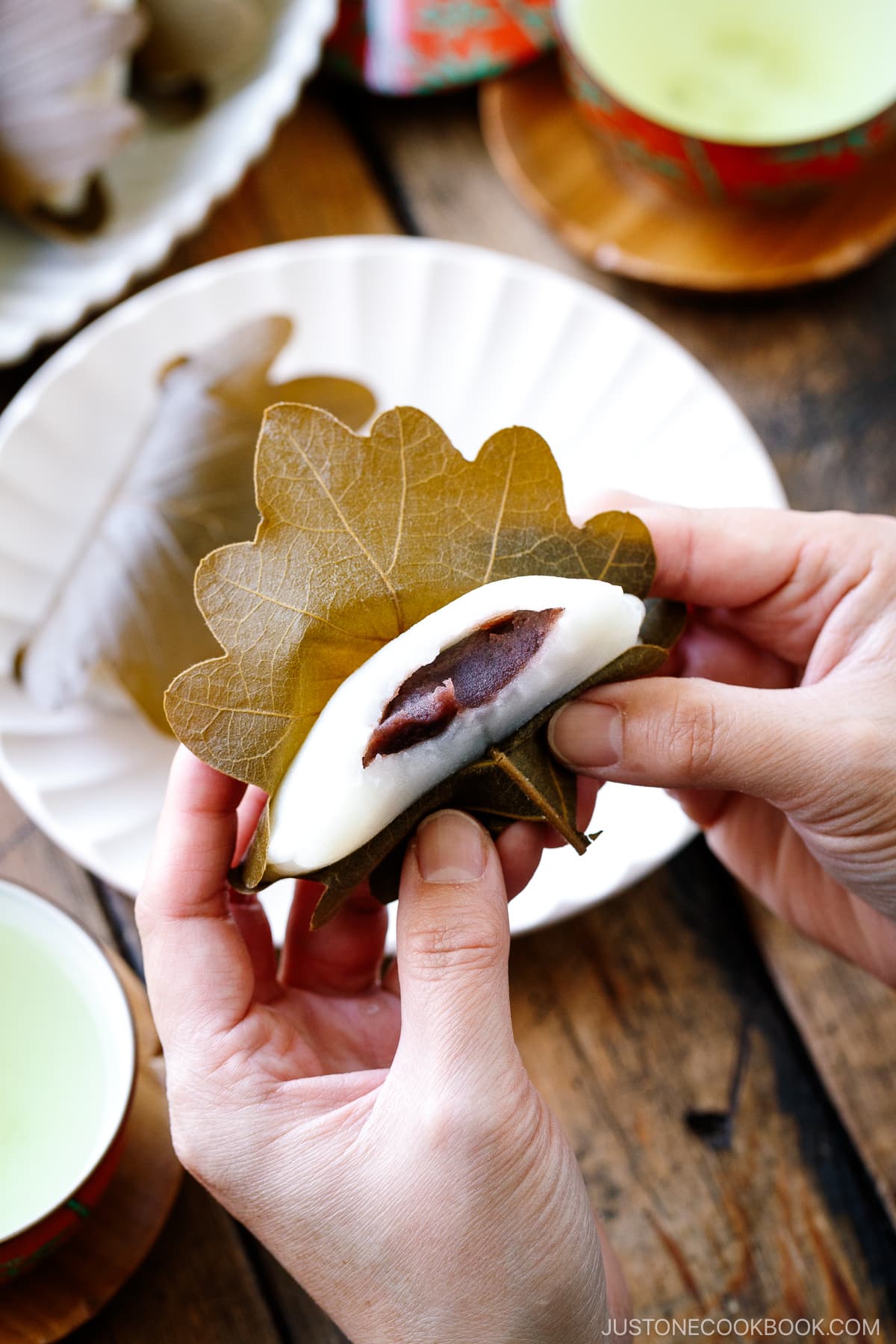
Let’s Celebrate Children’s Day
Children’s Day was originally called Tango no Sekku (端午の節句)—translated to Boy’s Day—and it was celebrated on the 5th day of the 5th moon in the lunar calendar. When Japan started to follow the Gregorian calendar in 1948, the date was moved to May 5. And the holiday was officially changed to celebrate both girls and boys.
On this special day, families fly carp-shaped streamers called Koinobori (Koinobori) outside their houses and display warrior dolls, miniature armor suits and samurai helmet.
Please read this post to learn more about Children’s Day in Japan.
We also have a special day dedicated to girls called the Girl’s Day or Hina Matsuri (Doll Festival) on March 3.
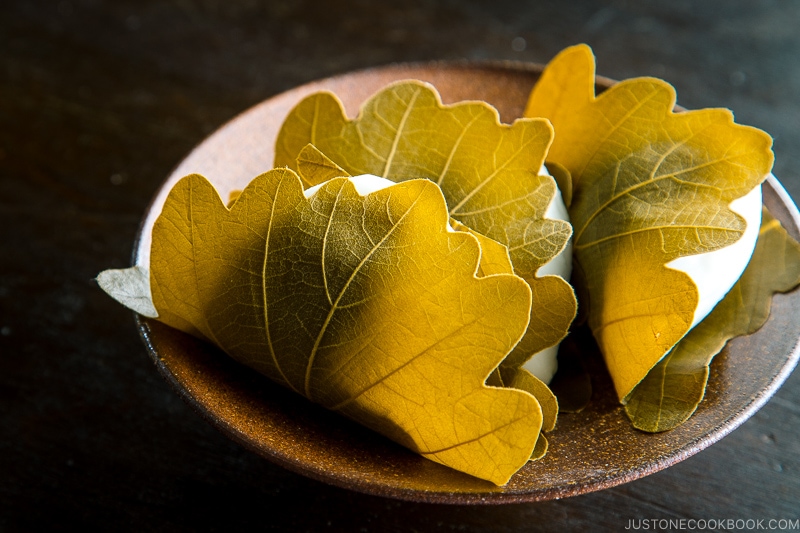
Wish to learn more about Japanese cooking? Sign up for our free newsletter to receive cooking tips & recipe updates! And stay in touch with me on Facebook, Pinterest, YouTubeand Instagram.
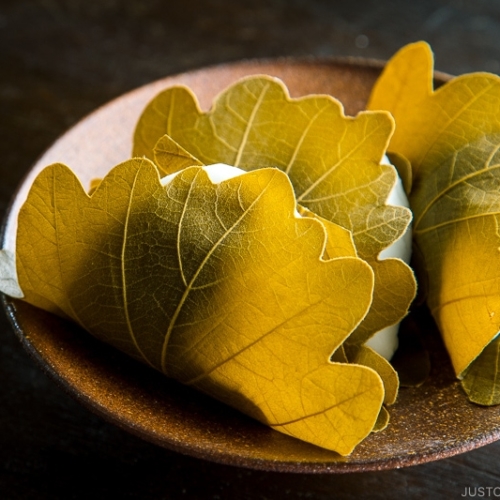
Kashiwa Mochi
Kashiwa Mochi is a tender Japanese rice cake filled with sweet red bean paste and wrapped with an oak leaf. We traditionally enjoy this soft and chewy confection on Children’s Day in Japan to celebrate a child’s growth and happiness.
Ingredients
Prevent your screen from going dark
Instructions
To Prepare the Leaves and Syrup
-
Rinse the oak leaves in running water and set aside to drain. If the oak leaves you purchased are the dried kind, boil them for 10 minutes. Then, soak them in water and drain well.
-
Combine the water and sugar for the syrup in a small bowl and mix well until the sugar is completely dissolved. Tip: I use a sugar-to-water ratio of 1:5 (by weight), but many people use 1:1 or 1:2. I use a flat whisk to mix it.
To Prepare the Filling
-
Scoop 1 heaping tablespoonful of red bean paste (25 g) and place it on a plate or tray. Make 8 portions per batch.
-
Wet your palms with the syrup. Pick up one portion of the red bean paste and place it on your palm.
-
Shape it into a nice ball by rolling it between your palms. Place on the tray or plate. Repeat with the remaining portions. Cover and refrigerate these sweet red bean balls to keep them firm.
To Make the Mochi Mixture
-
In a large bowl, mix the joshinko and sugar with a whisk.
-
Add about 85–90% of the measured water to the bowl now, and reserve the remaining 10–15% of it for later. Mix well with a whisk to combine. The mixture should still be rather dry. Now, gradually add the reserved water, a little bit at a time, to loosen it up. Mix well after each addition and check the texture to decide if you need to add more.
-
The final texture of the mixture should be thick but runny. When you lift the whisk, the mixture should fall in a thick ribbon pattern that sits on top of the swirl (see my image). You may not need to use all the water or you may need additional water. Loosely cover the bowl with plastic wrap.
To Cook the Mochi Mixture
To Pound and Knead the Mochi
To Shape the Mochi
-
Take one portion of the mochi and roll it into a cylinder shape. Then, press down on it with your palm.
-
With a rolling pin, roll the cylinder of mochi into a flat oval shape, roughly 2¾ inches x 4⅓ inches (7 cm x 11 cm).
-
Continue rolling out the rest of the pieces. Keep the finished ones under the plastic or tea towel. Next, take one piece and pick the smoother side as the presentation side (the outer side of the mochi).
-
With the presentation side down, place a red bean paste ball in the center of the mochi and fold the mochi in half. Then, seal the mochi’s edges around the red bean paste. Make sure to dip your fingers in the syrup so they won’t stick to the mochi.
-
Press down the edges to seal nicely. If your red bean ball is too big or your mochi is too narrow, it’ll be hard to seal the edges. In this case, roll out the mochi a bit more to make it wider.
-
Wrap each mochi in a drained but still moist oak leaf, with the back side of the leaf (with more visible veins) facing out. Place the Kashiwa Mochi on a plate. Repeat to form the rest of the Kashiwa Mochi.
Nutrition
Nutrition Facts
Kashiwa Mochi
Amount per Serving
% Daily Value*
* Percent Daily Values are based on a 2000 calorie diet.
©JustOneCookbook.com Content and photographs are copyright protected. Sharing of this recipe is both encouraged and appreciated. Copying and/or pasting full recipes to any website or social media is strictly prohibited. Please view my photo use policy here.
Editor’s Note: This post was originally published on April 27, 2015. The post has been updated with a revised recipe, new pictures, and more helpful content on April 6, 2023.

